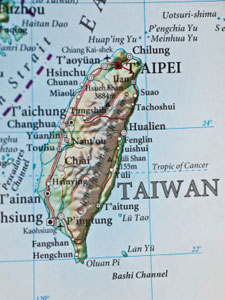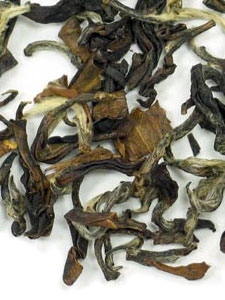Taiwanese (Formosa) Tea


When Portugese sailors first laid eyes on the towering, mist-shrouded mountains ninety miles from the coast of China they dubbed the island, "Formosa" — the beautiful island. The year was 1590 and it's unlikely they could have known the beauty and variety of teas this verdant isle would become home to.
The long history of tea in Taiwan (previously known as Formosa) is an arc defined by two things: small family gardening and the oolong. Over 90% of Taiwan's total tea production is oolongs.
Smallest of all traditional tea producing nations, Taiwan does not have ideal geography for large-scale tea production. Most farms on the island harvest four times a year, with the altitude of certain crops limiting their plucking to twice a year. However, that same geography: the cool, humid and mountainous landscape, coupled with centuries of expertise inherited from both Japanese and Chinese tea cultures make Taiwanese teas nonpareil in quality.
History
Though the Portugese, Spanish, Chinese and Japanese would all lay claim to the archipelago at some point, it was the Dutch who were first responsible for developing the tea trade in Taiwan. The year was 1624 and Taiwan served as a strategic seafaring port between China and ships bound for Europe. The foundation they set positioned Taiwan to be a leading tea producer, even as the Qing Dynasty reconquered and unified Taiwan with the mainland Fujian province, not sixty years later. The subsequent wave of Chinese immigration onto the island altered its tea culture irrevocably.
Over the next several decades, tea farmers from the renowned Anxi and Wuyi regions poured in, bringing with them their plants and tricks of the trade. The Taipei and Nantou regions became epicenters of family tea farming. At the time, most tea was grown for personal consumption. Rice and sugarcane remained Taiwan's cash crops but by the late 1700s, the international tea trade had kicked into high gear.
In 1866 a British trader named John Dodd began championing Taiwanese teas on the world market. He offered financing to family-farming peasants who agreed to start plantations and built factories in the capital, Taipei, allowing growers control over every stage of production for the first time.
This industrialization continued with the Japanese conquest in 1895. More and more, the family gardens of Taiwan were converted into mechanized factory farms. The Japanese introduced Tea Institutes and even offered training to aspiring tea masters. They also endorsed black tea production in the country, partially to avoid competition with their domestic green tea market.
After World War II, the Chinese reclaimed Taiwan and re-oriented it toward low-grade green tea production, meant for trade with Japan and North Africa. In the civil war that ensued not long after, Taiwan became home to The Republic of China. Now, unable to compete with the mainland for green tea markets and with Japan fast becoming self-sufficient, Taiwan embraced an age-old style and local favorite: the oolong.
Spending power was increasing in the country and with a mind for quality over quantity, Taiwan returned to the small, family garden culture it had originated from. Until the eighties, most Taiwanese teas were exported. The government culled these tendencies by opening museums, staging competitions and throwing tea festivals. Today there are over 30,000 tea growers in the nation, a majority of them with no more than two to eight employees.
Culture
Taiwan is also the only major producer to evaluate all three aspects of tea experience when grading: leaf appearance, aroma and flavor. In fact, they host biannual tea competitions in the major growing regions to encourage quality. Farmers submit their finest teas to be judged by a panel of experts, the winning teas are awarded gold, silver and bronze medals. Farmers who produce gold medal teas are met with renown and a very sizable income from sales of that harvest - at times, it creates a "futures market" for the tea, with customers buying out the next year's harvest before the leaf is even on the bush. Because of its domestic popularity, tea in Taiwan is imported at a rate of three times more than its exported.
Famous Formosa Teas
Pouchong ("Bao Zhong") -This lightly oxidized oolong has large, wavy, dark green leaves which yield a pale, golden-yellow cup. Processing involves a minimal amount of rolling (each twist using only a single leaf) and a light roast. Pouchong literally translates to "paper wrapped," a reference to how the leaf was originally presented. Pinglin, the town of its origin, is situated in the mountains thirty minutes from Taipei — a popular daytrip for locals and tourists. Originally produced for scenting, this tea is beloved for its delicate floral flavor, buttery texture and light earthy undertones. Example: Formosa Pouchong.
Tung Ting ("Dong Ding") -The oldest and most renowned of all Taiwanese tea styles, Dong Ding is processed with light or medium oxidation and is notable for its tightly rolled Min Nan (bead or globe) style leaves as well as its full, sweet and clean flavor. Grown in the mountains of Nantou at altitudes exceeding 1,600 feet, Tung Ting is traditionally made from the Qin Xin cultivar, one of the originals brought over from the Fujian province of China. This tea boasts a deep honey aroma, buttery mouthfeel, and notes of lilac with a fresh vegetal finish. Example: Ali Shan.
Bai Hao ("Oriental Beauty) -Bai Hao is grown in the highlands of Hsinchu, a northwestern province and is oxidized between 65-70%. In the case of this style, leaves are bitten by the Jacobiasca formosana insect, a tiny leaf-hopper. This triggers the release of a defensive hormone in the plant, which is amplified by oxidation. It just so happens that this hormone is pretty tasty. Only leaves and buds that have been bitten are picked, giving Bai Hao its beautiful, autumnal grey-reddish appearance. Look for lush, smooth flavors of honey, apple and juicy stone fruit. Bai Hao's have a multitudinous complexity and a lingering, clean finish. Example: Formosa Bai Hao #40.
Gao Shan Cha ("High Mountain Tea") -A broad classification, signifying any tea that grows at a height of more than 1,000 meters (3,300 feet) above sea level — many Taiwanese oolongs fall into this category, including Ali Shan, Li Shan and Shan Lin Xi. Gao Shan chas are renowned for their pronounced aromatics, roasted vegetal flavors, decadent bodies and luxuriant floral finishes. Gao Shan Chas are grown primarily in the middle of the island, on the Central Mountain massif, some gardens thriving at heights well over 8,000 feet.
 teaclass
teaclass
